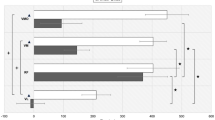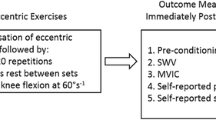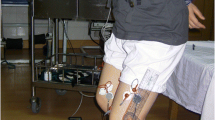Abstract
Objective
The aim of our study was to define and compare the mechanical properties of the vastus lateralis (VL) and vastus medialis obliquus muscles (VMO) by the way of quantitative shear-wave elastography in male and female healthy control (HC) subjects, and in female patients with patellofemoral pain syndrome (PFPS).
Materials and methods
Twenty-two healthy volunteers (11 male and 11 female) and 11 female patients with anterior knee pain were included in the study. The SWE examinations for VL and VMO were performed while the subjects were performing open kinetic chain exercises in neutral and 30° hip abduction. The contraction capacity (CC) and contraction ratio (CR) values were determined in resting and contraction phases in both hip positions.
Results
The mean elasticity values in the CC for VL and VMO muscles were significantly higher in male HC subjects when compared to female HC subjects (p < 0.05). The CR of the VL muscle in female patients with PFPS was not significantly different than the female HC group. The CR for the VMO muscle was significantly lower in female patients with PFPS when compared to female HC subjects (p < 0.05).
Conclusions
We found a significant VMO weakness, and this method may provide quantitative data that might influence the diagnosis of muscle weakness, in female patients with PFPS.


Similar content being viewed by others
References
Avraham F, Aviv S, Ya’akobi P, et al. The efficacy of treatment of different intervention programs for patellofemoral pain syndrome—a single blinded randomized clinical trial. Pilot study. Sci World J. 2007;24:1256–62.
Chiu JK, Wong YM, Yung PS, et al. The effects of quadriceps strengthening on pain, function, and patellofemoral joint contact area in persons with patellofemoral pain. Am J Phys Med Rehabil. 2012;91:98–106.
Harvie D, O’Leary T, Kumar S. A systematic review of randomized controlled trials on exercise parameters in the treatment of patellofemoral pain: what works? J Multidiscip Healthc. 2011;4:383–92.
Wong YM, Ng GY. The relationships between the geometrical features of the patellofemoral joint and patellar mobility in able-bodied subjects. Am J Phys Med Rehabil. 2008;87:134–8.
Mascal CL, Landel R, Powers C. Management of patellofemoral pain targeting hip, pelvis, and trunk muscle function: 2 case reports. J Orthop Sports Phys Ther. 2003;33:647–60.
Cowan SM, Bennell KL, Crossley KM, et al. Physical therapy alters recruitment of the vasti in patellofemoral pain syndrome. Med Sci Sports Exerc. 2002;34:1879–85.
Cowan SM, Bennell KL, Hodges PW, et al. Delayed onset of electromyographic activity of vastus medialis obliquus relative to vastus lateralis in subjects with patellofemoral pain syndrome. Arch Phys Med Rehabil. 2001;82:183–9.
Sakai N, Luo ZP, Rand JA, et al. The influence of weakness in the vastus medialis oblique muscle on the patellofemoral joint: an in vitro biomechanical study. Clin Biomech (Bristol, Avon). 2000;15:335–9.
Syme G, Rowe P, Martin D, et al. Disability in patients with chronic patellofemoral pain syndrome: a randomised controlled trial of VMO selective training versus general quadriceps strengthening. Man Ther. 2009;14:252–63.
Gennisson JL, Deffieux T, Macé E, et al. Viscoelastic and anisotropic mechanical properties of in vivo muscle tissue assessed by supersonic shear imaging. Ultrasound Med Biol. 2010;36:789–801.
Beck TW, Housh TJ, Johnson GO, et al. Mechanomyographic and electromyographic responses during submaximal to maximal eccentric isokinetic muscle actions of the biceps brachii. J Strength Cond Res. 2006;20:184–91.
Malek MH, Coburn JW. The utility of electromyography and mechanomyography for assessing neuromuscular function: a noninvasive approach. Phys Med Rehabil Clin N Am. 2012;23:23–32.
Bensamoun SF, Ringleb SI, Littrell L, et al. Determination of thigh muscle stiffness using magnetic resonance elastography. J Magn Reson Imaging. 2006;23:242–7.
Van Campen A, De Groote F, Bosmans L, et al. Functional knee axis based on isokinetic dynamometry data: Comparison of two methods, MRI validation, and effect on knee joint kinematics. J Biomech. 2011;13:2595–600.
Qi L, Wakeling JM, Ferguson-Pell M. Spectral properties of electromyographic and mechanomyographic signals during dynamic concentric and eccentric contractions of the human biceps brachii muscle. J Electromyogr Kinesiol. 2011;21:1056–63.
Schreiber JU, Mucha E, Fuchs-Buder T. Acceleromyography to assess neuromuscular recovery: is calibration before measurement mandatory? Acta Anaesthesiol Scand. 2011;55:328–31.
Chester R, Smith TO, Sweeting D, et al. The relative timing of VMO and VL in the aetiology of anterior knee pain: a systematic review and meta-analysis. BMC Musculoskelet Disord. 2008;1:64.
Smith TO, Bowyer D, Dixon J, et al. Can vastus medialis oblique be preferentially activated? A systematic review of electromyographic studies. Physiother Theory Pract. 2009;25:69–98.
Gennisson JL, Cornu C, Catheline S, et al. Human muscle hardness assessment during incremental isometric contraction using transient elastography. J Biomech. 2005;38:1543–50.
Davis J, Kaufmann KR, Lieber RL. Correlation between active and passive isometric force and intramuscular pressure in the isolated rabbit tibialis anterior muscle. J Biomech. 2003;36:505–12.
Nordez A, Hug F. Muscle shear elastic modulus measured using supersonic shear imaging is highly related to muscle activity level. J Appl Physiol. 2010;108:1389–94.
Antich TJ, Brewster CE. Modification of quadriceps femoris muscle exercises during knee rehabilitation. Phys Ther. 1986;66:1246–51.
Bose K, Kanagasuntheram R, Osman MBH. Vastus medialis oblique: an anatomic and physiologic study. Orthopedics. 1980;3:880–3.
Shinohara M, Sabra K, Gennisson JL, et al. Real-time visualization of muscle stiffness distribution with ultrasound shear wave imaging during muscle contraction. Muscle Nerve. 2010;42:438–41.
Witvrouw E, Werner S, Mikkelsen C, et al. Clinical classification of patellofemoral pain syndrome: guidelines for non-operative treatment. Knee Surg Sports Traumatol Arthrosc. 2005;13:122–30.
Jan MH, Lin DH, Lin JJ, et al. Differences in sonographic characteristics of the vastus medialis obliquus between patients with patellofemoral pain syndrome and healthy adults. Am J Sports Med. 2009;37:1743–9.
LaBella C. Patellofemoral pain syndrome: evaluation and treatment. Prim Care. 2004;31:977–1003.
Zappala FG, Taffel CB, Scuderi GR. Rehabilitation of patellofemoral joint disorders. Orthop Clin N Am. 1992;23:555–66.
Acknowledgments
The authors have not received any financial assistance in the preparation of this manuscript.
Author information
Authors and Affiliations
Corresponding author
Additional information
Ethics approval
The local ethics committee (07/02/2012 dated and A-54 numbered) of the study hospital approved the study protocol, and written informed consent was obtained from every volunteer and patient for the SWE procedures. The study was made according to latest form of the Declaration of Helsinki (as amended by the 59th World Medical Association General Assembly, Seoul, October 2008).
Rights and permissions
About this article
Cite this article
Botanlioglu, H., Kantarci, F., Kaynak, G. et al. Shear wave elastography properties of vastus lateralis and vastus medialis obliquus muscles in normal subjects and female patients with patellofemoral pain syndrome. Skeletal Radiol 42, 659–666 (2013). https://doi.org/10.1007/s00256-012-1520-4
Received:
Revised:
Accepted:
Published:
Issue Date:
DOI: https://doi.org/10.1007/s00256-012-1520-4




